If you’re ready to take control of your fitness routine, building a home gym is the perfect solution. In this ultimate guide, we’ll walk you through everything you need to know about creating a functional and efficient workout space at home. From understanding the benefits of home gym equipment to selecting the essential gear for your goals, this guide will help you design a gym that fits your space, budget, and fitness aspirations. With the right setup, you’ll have the convenience and flexibility to work out anytime, without the need for a crowded gym membership.
Let’s dive into how you can create the perfect home gym setup in 2024.
Planning Your Home Gym
Planning your home gym is the most crucial part of the process. You need to take into account what sort of exercises you plan on doing to achieve your fitness goals for example if you plan on training gymnastics at home you’ll need a lot more space compared to weightlifting where you can maximise your gains and results in a tighter area. Another thing you need to take into account is the budget you’ve set for it. In this guide we will give you all the information you need.
Assessing Your Space
Before you begin purchasing equipment, it’s important to assess the space available for your home gym. The type and amount of equipment you can install will depend heavily on the size and layout of the room. Common options for a home gym include garages, spare rooms, and basements.
For those with limited space, maximizing the efficiency of your setup is crucial. Consider foldable equipment or gear that serves multiple functions, like resistance bands, adjustable dumbbells, or wall-mounted racks. Vertical storage solutions can also keep the area tidy and open for movement.
Check out our post of Best Home Gym Equipment for Small Spaces: Top 5 Picks here
Setting a Budget
One of the most important steps in planning your home gym is setting a realistic budget. Having a budget ensures that you make smart purchases and avoid overspending on unnecessary equipment.
Home gym setups can vary greatly in price depending on your fitness goals and the equipment you select. A basic setup with essential items like a yoga mat, resistance bands, and dumbbells could cost under £200, while a more advanced gym with machines like a treadmill, squat rack, and multi-station setup can run into thousands.
It’s important to balance quality and cost. Investing in a few high-quality pieces rather than numerous cheaper options will ensure durability and better long-term use. Start with the essentials and expand your gym over time as your needs and budget allow.
If your struggling check out How to Build a Complete Home Gym on a Budget here
Identifying Your Fitness Goals
Your fitness goals will significantly shape the equipment you need to include in your home gym. Different goals require different tools and setups:
Aligning your equipment choices with your specific fitness goals will ensure that you create a gym setup that supports your personal development and fitness journey.
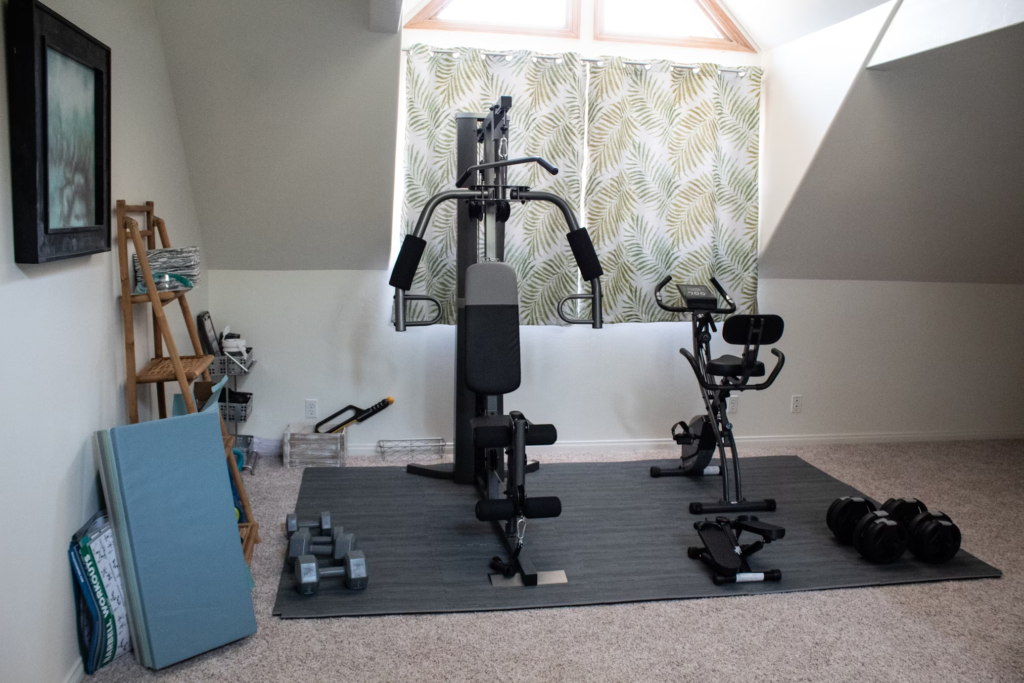
Essential Home Gym Equipment
Here’s some our favourite essential home gym equipment that’s helped us:
Cardio Equipment
Cardio equipment is a key component of any home gym, helping to improve heart health, endurance, and overall fitness. There are several types of cardio machines to consider, each with its own pros and cons based on your fitness goals, space, and budget.

1.Treadmills
Treadmills are versatile for walking, jogging, and running at home. They allow you to adjust speed and incline to simulate outdoor conditions.
Pros: Great for all fitness levels, indoor running, and customizable intensity.
Cons: Can take up a lot of space and be expensive.
Check out our in depth guide to treadmills here
2.Cross Trainer
Elliptical machines offer a low-impact alternative to running, making them ideal for people with joint issues. They provide a full-body workout by engaging both the arms and legs.
Pros: Low impact, joint-friendly, and offers both upper and lower body movement.
Cons: Often large and can be more expensive than some other cardio options.
Check out our in depth guide to cross trainers here
3.Exercise Bikes
Stationary bikes, including upright and recumbent models, are compact and perfect for home use. They provide an excellent cardio workout while being easier on the knees than running.
Pros: Compact, low-impact, and great for high-intensity interval training (HIIT).
Cons: Doesn’t provide an upper body workout.
4.Rowing Machines:
Rowers offer a full-body workout, combining cardio with strength training. They are particularly effective for engaging the back, arms, and legs.
Pros: Full-body workout, space-efficient, and suitable for various fitness levels.
Cons: May not appeal to people who prefer running-based cardio.
5.Skipping rope/ Jump rope
A simple yet highly effective tool for cardiovascular training. It improves coordination, burns calories, and enhances endurance.
Pros: Extremely portable, inexpensive, and efficient.
Cons: Requires coordination and space for use.
Check out our ultimate guide to skipping/ jump rope here
Choosing the right cardio machine depends on your fitness goals and available space. If space is limited, consider foldable or compact machines that can be stored easily.
Check out our Top 7 Cardio Machines for Effective Home Workouts here
Strength Training Equipment
Strength training is essential for building muscle, improving bone density, and enhancing overall physical health. When selecting strength training equipment for your home gym, consider both free weights and machines, depending on your goals and space constraints.
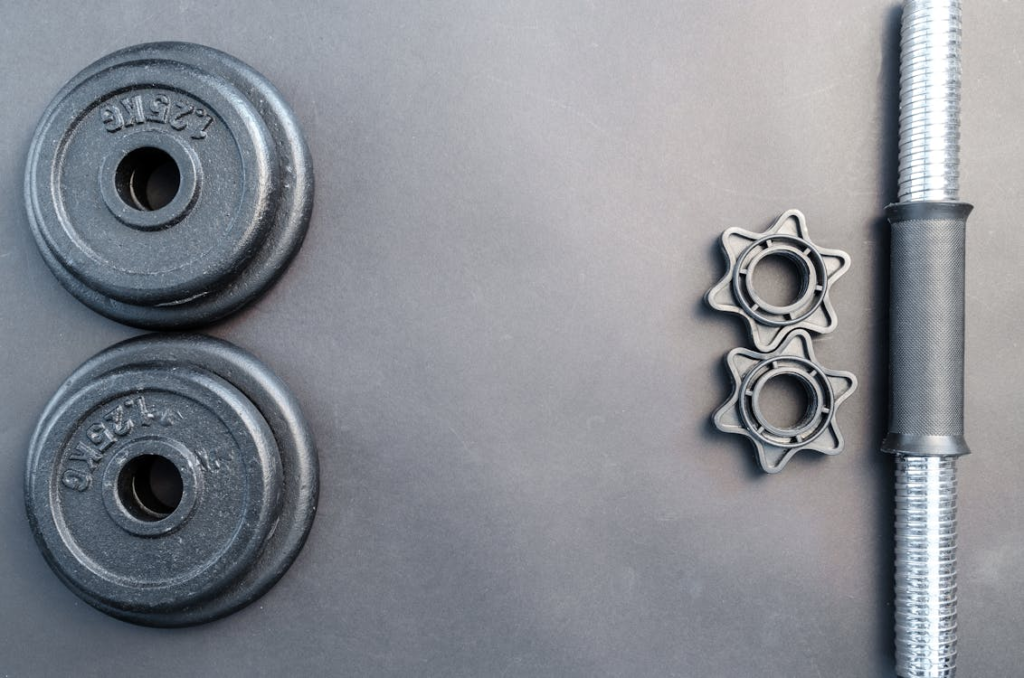
1.Dumbbells
Adjustable or fixed dumbbells are great for both beginners and advanced lifters. They are compact and can be used for a wide variety of exercises targeting multiple muscle groups.
Check out our guide to the Best Adjustable Dumbbells for Home Use: Our Top Picks here
2.Barbells
Barbells are ideal for heavy lifting and compound movements like squats, deadlifts, and bench presses. They require more space but are essential for serious strength training.
Check out our ultimate guide to barbells here
3.Kettlebells
Kettlebells are excellent for functional movements, core work, and explosive exercises like kettlebell swings. Their unique shape allows for dynamic, full-body workouts.
4.Weight Plates
Used in combination with barbells or dumbbells, weight plates allow for adjustable resistance. They can also be used independently for exercises like plate presses or overhead carries.
5.Resistance Bands/ exercise bands
Resistance bands/ exercise bands are a highly affordable and space-saving option for strength training. They are perfect for beginners or those looking for a low-impact alternative to weights. Resistance bands come in different levels of tension, making them suitable for various exercises, from stretching to strength building.
Check out our ultimate all in one guide to resistance bands here
6.Multigyms
Multi-gyms offer a variety of exercises in one compact machine, making them suitable for people who want a range of strength-building options without needing multiple machines. They are especially useful for beginners as they guide proper form and minimize the risk of injury.
7.Cable Machines
Highly functional machines that can be used for a wide range of exercises, from cable chest flies to tricep pushdowns. They offer variable resistance and a smooth motion, making them a favourite for isolating muscles.
Check out our all in one guide to cable machines here
8.Squat Rack
A squat rack is crucial for performing heavy lifts like squats, bench presses, and overhead presses. It allows you to lift safely by providing adjustable safety bars to catch the weight if necessary. Compact racks are available for smaller spaces, while larger racks often include features like pull-up bars.
Check out our comparison guide of folding squat racks vs wall mounted squat racks here
9.Power Rack
Similar to the squat rack but offering more functionality, a power rack provides a safe environment for barbell exercises. It includes safety arms and sometimes weight storage. Many power racks also come equipped with pull-up bars and can be customized with additional attachments.
10.Adjustable Bench
An adjustable bench adds versatility to your strength training routine, allowing you to perform exercises like bench presses, seated shoulder presses, and incline dumbbell rows. Its ability to change angles makes it a valuable addition to any gym.
11.Pull-Up Bar
Pull-ups are one of the most effective exercises for upper body strength, targeting the back, shoulders, and arms. A pull-up bar can be mounted in a doorway or included as part of a power or squat rack. It’s a space-saving, powerful tool for bodyweight training.
Functional Training Equipment
Functional training improves your overall movement patterns, flexibility, and core strength. Here are some key tools for this style of training:
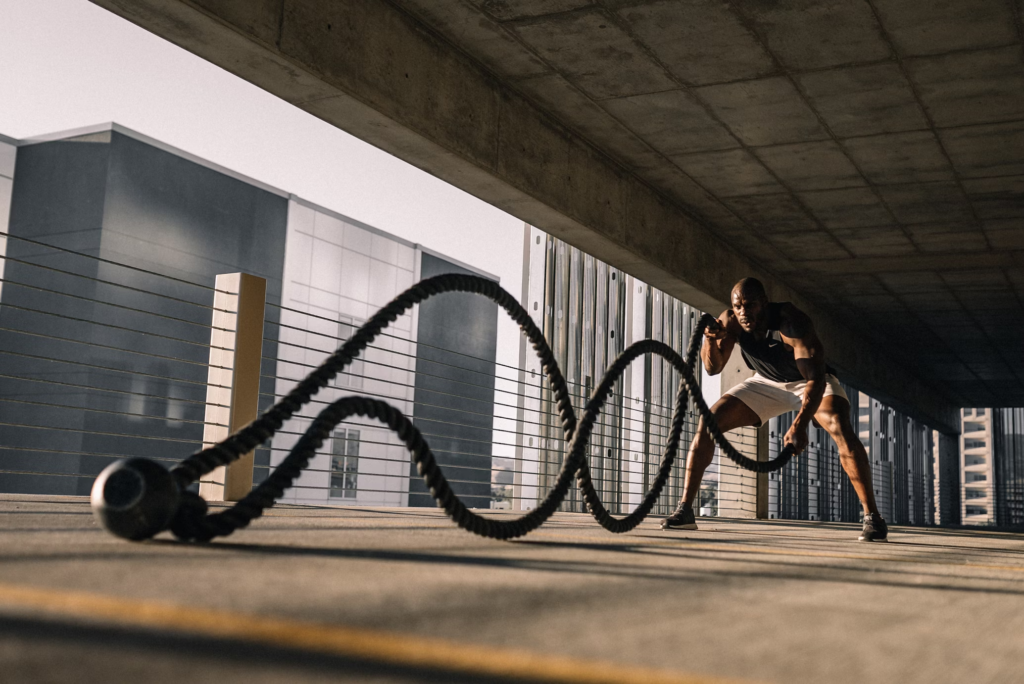
1.Battle Ropes
Battle ropes provide a high-intensity workout that combines cardio with strength. They’re perfect for short, intense bursts of effort, working the arms, shoulders, and core simultaneously.
Pros: Great for cardio and muscle endurance.
Cons: Requires a dedicated space for use.
2.Medicine Balls/ slam ball
Excellent for explosive movements like throws and slams, medicine balls/ slam balls improve coordination and core strength. They can also be used for more traditional strength training exercises like squats and lunges.
3.Exercise ball
Stability balls engage the core and improve balance. They are perfect for exercises like crunches, planks, or stability ball rollouts.
4.Foam Rollers
Essential for recovery, foam rollers help relieve muscle soreness and increase flexibility. Using them post-workout can aid in reducing muscle tightness and improving recovery time.
Check out our post on the benefits of foam rollers here
5.Exercise Step
An exercise step is great for lower body workouts like step-ups and can also be used in cardio routines for high-intensity training. It’s lightweight, adjustable, and perfect for home use.
6.Yoga Mat
A yoga mat is essential for performing floor exercises, yoga, or stretching routines. It provides cushioning, preventing injury and making bodyweight exercises more comfortable.
These accessories are often compact, making them great for small spaces. They are also versatile, allowing you to incorporate them into a wide range of workouts for better overall fitness.
Check out Top 10 Home Gym Accessories to Enhance Your Workouts here
Creating a Well-Rounded Home Gym
1.Balancing Cardio and Strength Equipment
When designing your home gym, it’s important to strike a balance between cardio and strength equipment. A well-rounded approach ensures that you’re building both cardiovascular endurance and muscle strength, which are crucial for overall fitness and health.

Importance of a Balanced Approach
Cardio workouts improve heart health, burn calories, and boost endurance, while strength training builds muscle, increases metabolism, and enhances functional fitness. Including both types of equipment in your gym will allow you to diversify your workouts and address multiple fitness goals. This balance prevents workout plateaus and reduces the risk of injury by ensuring that no area of your fitness is neglected.
Sample Equipment Combinations for Different Goals
Your choice of equipment should reflect your primary fitness objectives. Below are a few examples of how to combine cardio and strength training equipment:
- For Weight Loss: If fat loss is your goal, prioritize cardio machines like a treadmill, exercise bike, or rowing machine combined with strength equipment such as dumbbells, kettlebells, and resistance bands.
- For Muscle Building: If building muscle is the primary goal, focus on strength-based equipment like barbells, weight plates, squat racks, and a power rack, with a simple cardio machine like a rower or jump rope to improve endurances
- For Overall Fitness: A balanced home gym for general fitness could include a mix of equipment, such as a stationary bike for cardio, a set of dumbbells, adjustable bench, and a pull-up bar for strength training, along with resistance bands for functional strength.
Balancing these components allows for versatility in your workouts, ensuring that you’re getting a full-body workout from home
2.Incorporating Flexibility and Recovery
While strength and cardio are crucial components of any fitness routine, flexibility and recovery are often overlooked. Incorporating flexibility and recovery equipment into your home gym is essential for improving range of motion, preventing injuries, and speeding up muscle recovery after intense workouts.
- Yoga Equipment: Yoga is excellent for improving flexibility, balance, and mental focus. Adding yoga gear such as a yoga mat, blocks, and straps will give you a dedicated space for stretching, balance exercises, and mindfulness. Practicing yoga regularly can enhance flexibility and relieve muscle tension, complementing your strength and cardio work.
- Foam Rollers and Massage Tools: Recovery tools like foam rollers, massage balls, or massage guns help release muscle tension and improve blood circulation. Foam rolling before or after workouts can reduce muscle soreness and increase flexibility, aiding in faster recovery times.
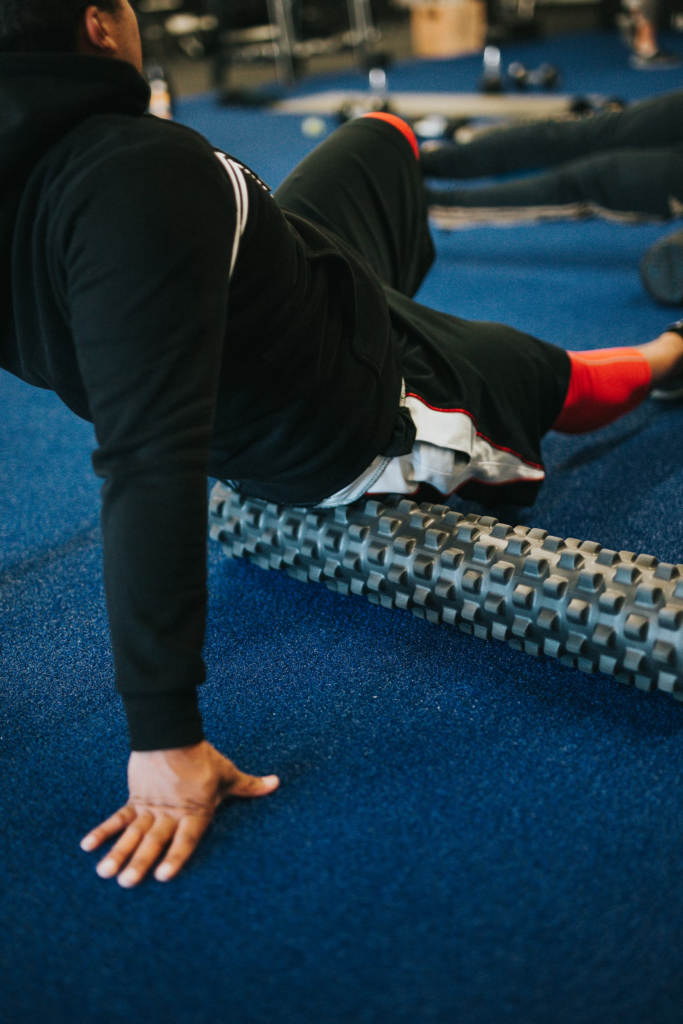
3.Smart Home Gym Technology
With advancements in fitness technology, smart home gym equipment can transform your workout experience by offering real-time feedback, personalized workout plans, and progress tracking. Incorporating tech-savvy options into your home gym setup allows you to optimize your workouts and stay motivated.

Overview of Smart Equipment and Its Benefits
Smart gym equipment offers several key advantages. From connected devices that monitor heart rate and calories burned to machines that automatically adjust resistance based on your performance, smart technology can make your workouts more efficient and tailored to your needs. Here are a few examples:
- Smart Treadmills and Bikes: These machines often feature interactive touchscreens that stream virtual classes or simulate outdoor environments, keeping your cardio workouts engaging and varied.
- Smart Strength Equipment: Devices like smart dumbbells or cable machines automatically track your reps, sets, and weight lifted, offering real-time insights into your strength progression. Some smart systems, such as connected power racks, even provide guided resistance based on your performances
- Wearable Fitness Tech: Integrating fitness trackers or smartwatches into your routine can provide a seamless way to monitor your overall fitness progress. These devices sync with many home gym machines and apps to track metrics such as heart rate, calories burned, and exercise intensity.
The Benefits:
| Personalization: Many smart machines adapt to your fitness level, allowing you to customize workouts in real-time. | Motivation: Virtual coaching, leader boards, and fitness challenges help keep you motivated and engaged. | Efficiency: Tracking your performance automatically saves time and helps you stay focused on your goals. |
Setting Up Your Home Gym
Setting up your home gym one of the key and most enjoyable parts of the process. These are the 3 major factors we consider when creating our homes gyms and helping others create there’s. These range from the type of flooring which is essential to all sports and exercises, to the best storage solutions to help maximise how many pieces of equipment and gadgets you use to help boost your workout , to finally the lighting and ventilation.
Lighting is key part of a home gym as it brightens up the room giving it more life and characters whilst most importantly boosting your mood, as well as ventilation which is needed in all gyms by lowering the temperature to stop you from overheating and getting the required amount of oxygen.
Flooring Options

Importance of Proper Flooring
One of the most important but often overlooked aspects of setting up a home gym is choosing the right flooring. Proper flooring not only protects your home’s existing floor from damage but also provides shock absorption, reduces noise, and enhances your workout experience. It’s especially important when using heavy weights or doing high-impact exercises.
The right flooring can also improve safety by offering better grip, reducing the risk of slips and injuries, and protecting your joints from excessive strain during workouts. In addition, it can make your home gym space feel more professional and comfortable.
Different Types of Flooring Options
When it comes to home gym flooring, there are several great options to consider, depending on your budget, workout needs, and space.
Rubber flooring is one of the best choices for home gyms, especially for strength training areas. It’s durable, provides excellent shock absorption, and protects your floors from heavy weights. Interlocking rubber tiles are easy to install and can be rearranged as needed.
Pros: Durable, shock-absorbing, and ideal for heavy equipment or weightlifting areas.
Cons: Can be more expensive than other options.
Foam tiles are lightweight and soft, making them great for low-impact activities like yoga, stretching, or bodyweight exercises. They are also cost-effective and easy to install. However, they may not hold up as well under heavy equipment like barbells or machines.
Pros: Soft, comfortable, and affordable.
Cons: Not ideal for heavy equipment or high-impact exercises.
If your gym area is already carpeted, it can work for certain types of exercise like yoga or light cardio. However, it’s not recommended for areas with heavy weights or equipment because it lacks shock absorption and can wear down quickly.
Pros: Soft and provides warmth.
Cons: Difficult to clean, can wear down, and is not suited for heavy equipment.
Vinyl is a good middle-ground option that provides a clean, sleek look and can handle moderate weights and cardio machines. It’s easy to clean and water-resistant, but it doesn’t offer as much cushion as rubber or foam.
Pros: Easy to clean and durable.
Cons: Less shock absorption
Choosing the right flooring will depend on your workout style and the equipment you plan to use. For most home gyms, a combination of rubber mats in weightlifting areas and foam tiles in areas used for stretching or bodyweight exercises works well.
Storage Solutions
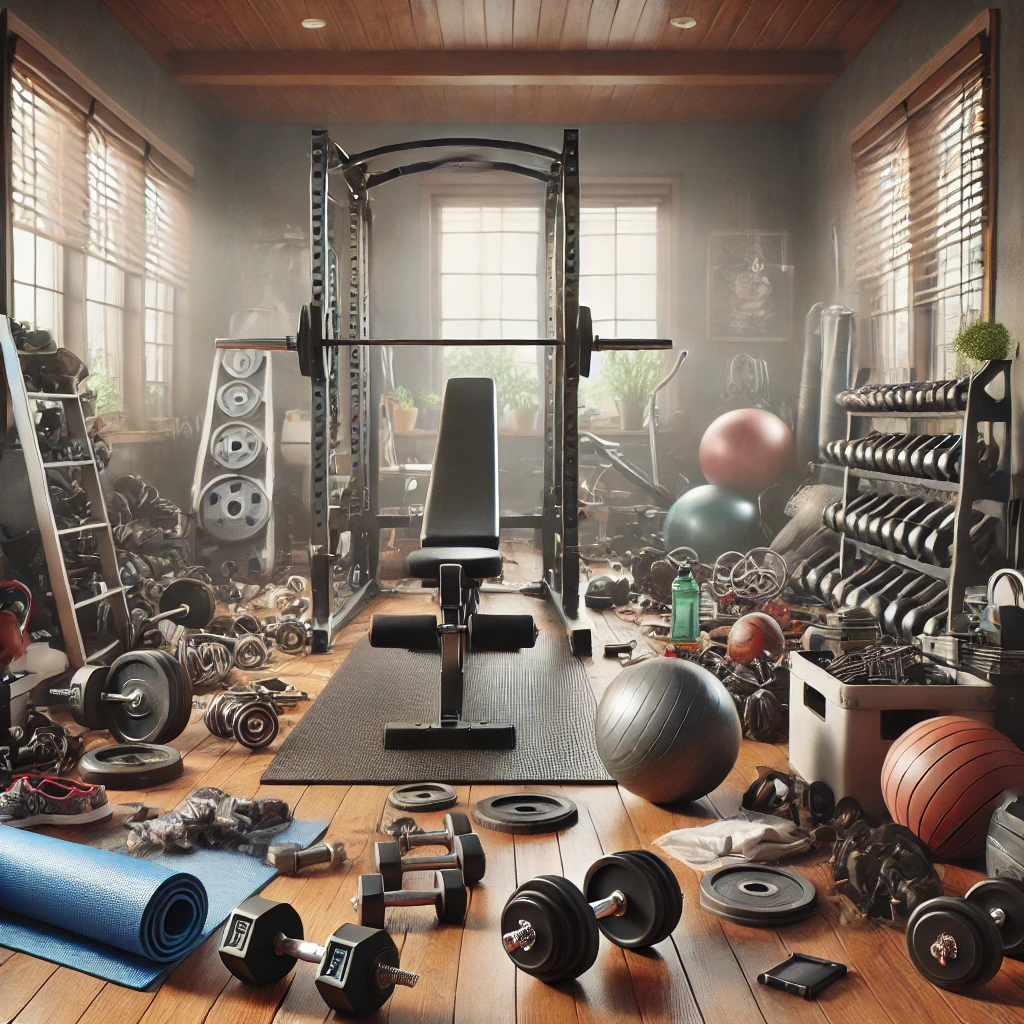
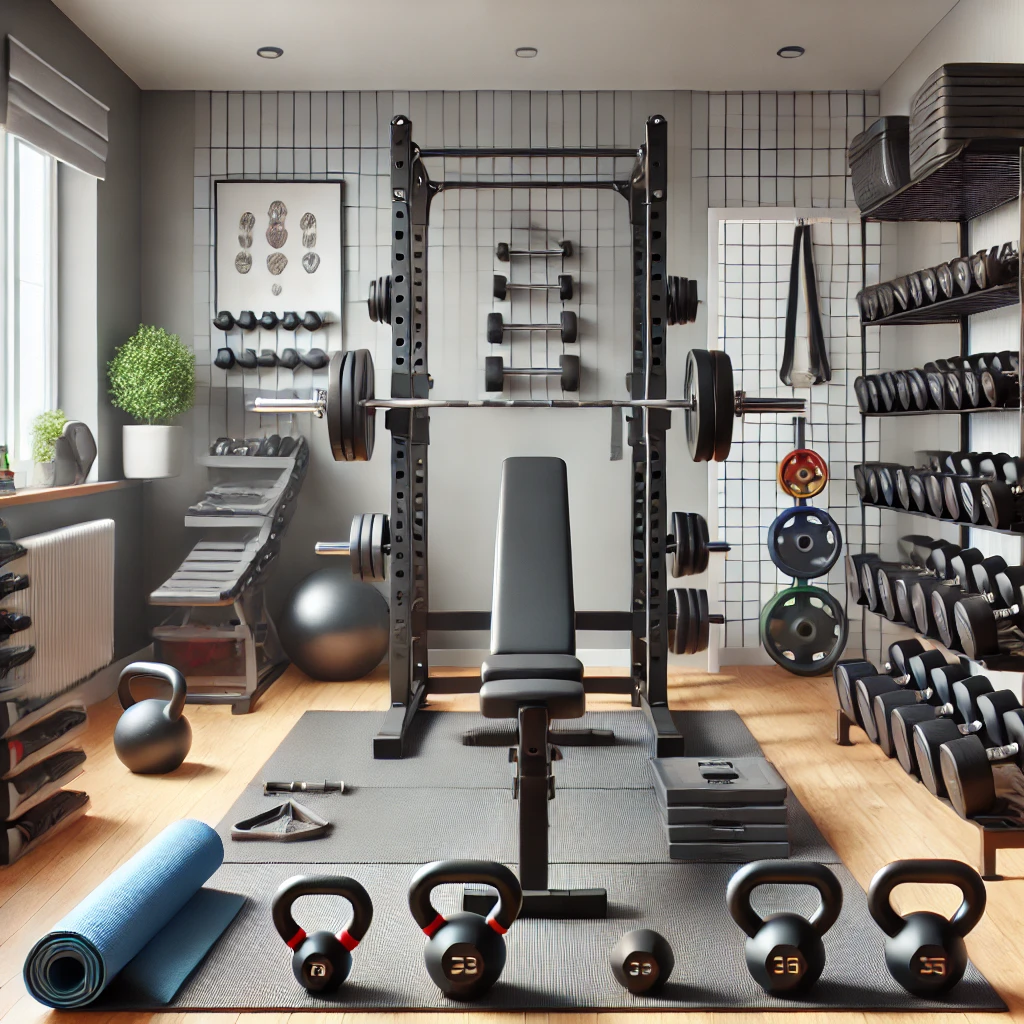
Keeping Your Gym Organized
Having a well-organized home gym can help you stay focused and motivated. Clutter-free spaces are more inviting and easier to navigate, ensuring that you can quickly transition between exercises without wasting time looking for equipment. Proper storage also helps prolong the life of your gear, preventing damage from improper handling or stacking.
Storage Ideas for Different Equipment Types
Organizing your home gym will make it feel more spacious and functional, allowing you to get the most out of your workout environment.
Lighting and Ventilation

Creating a Comfortable Workout Environment
Proper lighting and ventilation are key to making your home gym a comfortable and motivating space. The right environment can help you stay focused and energized, while poor lighting or ventilation can detract from your workout experience.
1.Lighting
Bright, natural light is ideal for workout spaces. If you have windows, make the most of natural daylight to create an uplifting atmosphere. If natural light isn’t an option, install bright LED lights to mimic daylight and keep the space well-lit. Dimmable lighting is a good option for yoga or meditation areas, allowing you to adjust the ambiance depending on the workout. Avoid fluorescent lights, which can be harsh and tiring on the eyes.
2.Ventilation
Proper ventilation is critical in a home gym, especially if you’re doing intense workouts. A well-ventilated space prevents the build up of odours, keeps the air fresh, and helps regulate temperature during exercise. If your gym is in a basement or garage, consider installing a fan or air purifier to keep the air circulating. Ceiling fans or portable fans can also help regulate airflow and keep the space cool during cardio sessions.
3.Temperature Control
For colder climates, space heaters can make your gym more comfortable, while air conditioning or portable fans are helpful for keeping things cool in the summer months. Proper insulation can also help maintain a consistent temperature, especially in garage or basement gyms.
By paying attention to lighting and ventilation, you can create a workout space that is comfortable, motivating, and conducive to regular exercise.
Maintenance and Safety
Equipment Maintenance
Keeping your home gym equipment in top condition is essential for both performance and longevity. Proper maintenance ensures that your machines, weights, and accessories continue to function safely and effectively, reducing the risk of breakdowns and injury.
Tips for Keeping Your Equipment in Top Condition
1.Regular Cleaning:
Sweat and dust can accumulate on your equipment, leading to wear and tear over time. Wipe down machines, weights, and benches after every use to keep them clean and free from moisture. Use a damp cloth and mild detergent to remove dirt, especially from high-contact areas like handles and seats.
2.Inspect for Wear and Tear
Frequently check cables, pulleys, resistance bands, and moving parts for signs of wear. Replace damaged or worn parts immediately to avoid injury and equipment failure.
3.Lubricate Moving Parts
For machines like treadmills, ellipticals, and rowing machines, it’s crucial to regularly lubricate moving parts such as belts, chains, and hinges. This reduces friction, prevents squeaking, and extends the life of t
4.Tighten Bolts and Screws
Over time, the vibration and movement of equipment like weight benches, squat racks, and power racks can loosen screws and bolts. Check and tighten these components periodically to ensure stability and safety.
5.Store Equipment Properly
When not in use, store weights, resistance bands, and other gear in designated storage areas to prevent damage. This also keeps your gym organized and safe for use.
Regular maintenance not only ensures that your equipment lasts longer but also provides a safer workout environment.
Check out how to maintain your home gym equipment for longevity here
Safety Considerations
Safety is paramount in any gym environment, and this is no different for your home gym. Knowing how to use your equipment correctly and practicing good form will help prevent injuries and ensure you get the most out of your workouts.
Proper Use of Equipment
1.Follow Manufacturer Guidelines
Always read and follow the user manuals provided with your gym equipment. This ensures that you’re setting up and using each piece correctly, which reduces the risk of injury.
2.Use Safety Features
Machines like treadmills, squat racks, and power racks often come with built-in safety features such as emergency stop buttons or safety arms. Make sure to familiarize yourself with these features and use them when necessary.
3.Start Light, Progress Gradually
When beginning a new exercise or using a new piece of equipment, start with a light weight or low intensity to ensure proper technique. Gradually increase the load or intensity as your strength and skill improve.

Importance of Form and Technique
1.Prioritize Good Form
Whether lifting weights, performing bodyweight exercises, or using machines, proper form is crucial to avoiding injury. Poor form can put unnecessary strain on muscles and joints, leading to long-term issues like sprains, strains, or worse.
2.Take Time to Learn Proper Technique
If you’re unfamiliar with an exercise, it’s worth spending time to learn the correct technique. There are plenty of resources, including instructional videos or personal trainers, who can help ensure you’re performing exercises safely and effectively.
3.Don’t Overdo It
Overtraining or using too much weight can increase the risk of injury. Listen to your body and ensure you take rest days to allow muscles to recover. If you feel pain or discomfort during an exercise, stop immediately and reassess your form.
By maintaining proper equipment care and ensuring safe practices, you’ll create a safer, more efficient home gym that helps you reach your fitness goals without unnecessary setbacks.
Getting Started with Your Home Workouts
Brief Overview of Creating a Workout Routine
Starting your fitness journey with a home gym can feel overwhelming at first, but creating a workout routine tailored to your goals will help set you on the right path. Begin by assessing your fitness objectives—whether it’s weight loss, muscle gain, or improving endurance—and then structure your workouts accordingly.
For a well-rounded routine, include exercises that target the following:
1.Cardio
Incorporate 20-30 minutes of cardio, such as using a treadmill, jump rope, or stationary bike. This will improve your heart health and endurance.
Check out our ultimate guide to cardio here
2.Strength Training
Focus on major muscle groups by incorporating weightlifting exercises using dumbbells, resistance bands, or your body weight. Compound movements like squats, deadlifts, and bench presses should form the core of your strength workouts.
Get Started with some easy yet super beneficial dumbbell exercises here
Check out some barbell back exercises you can do at home ranging from beginner to advanced here
3.Flexibility and Recovery
Dedicate some time to stretching, yoga, or foam rolling after each workout to improve flexibility and aid recovery.
Create a schedule that alternates between different types of workouts—cardio, strength, and flexibility—to ensure balance and prevent burnout. Start small and gradually increase the intensity and duration of your workouts as your fitness improves.

Importance of Consistency
Consistency is the key to long-term success in fitness. Working out regularly, whether it’s three days a week or daily, will help you build momentum and see steady progress over time. The more consistent you are with your workouts, the easier it becomes to make exercise a part of your routine, helping you achieve your goals faster.
To stay consistent:
- Set realistic goals and track your progress.
- Schedule workouts at times that fit your daily routine.
- Make your workouts enjoyable by switching up exercises and incorporating activities you like.
Remember, fitness is a long-term commitment. Even on days when motivation is low, sticking to your routine, even with a lighter workout, will keep you moving forward.
Check out our ultimate guide to exercising with home gym equipment here
Conclusion
Building a home gym is an exciting and empowering step toward taking control of your fitness journey. Throughout this guide, we’ve covered the key elements to help you get started, including assessing your space, choosing the right equipment, maintaining your gym, and prioritizing safety.
To recap:
- Plan your space carefully by choosing the right location, setting a budget, and aligning your equipment with your fitness goals.
- Equip your gym with a balance of cardio, strength, and functional training tools to create a well-rounded workout environment.
- Set up your gym for long-term success with proper flooring, storage solutions, and attention to lighting and ventilation.
- Maintain and use equipment safely, ensuring longevity and preventing injuries by following correct form and techniques.
Now is the perfect time to take the first steps toward creating your own fitness haven at home. Whether you start with just a few essential items or invest in a full setup, what matters most is making the space work for your goals and lifestyle. With consistency and dedication, your home gym will become a cornerstone of your fitness routine, helping you achieve long-term health and well-being.
Get started today—your ideal home gym is just a few steps away!

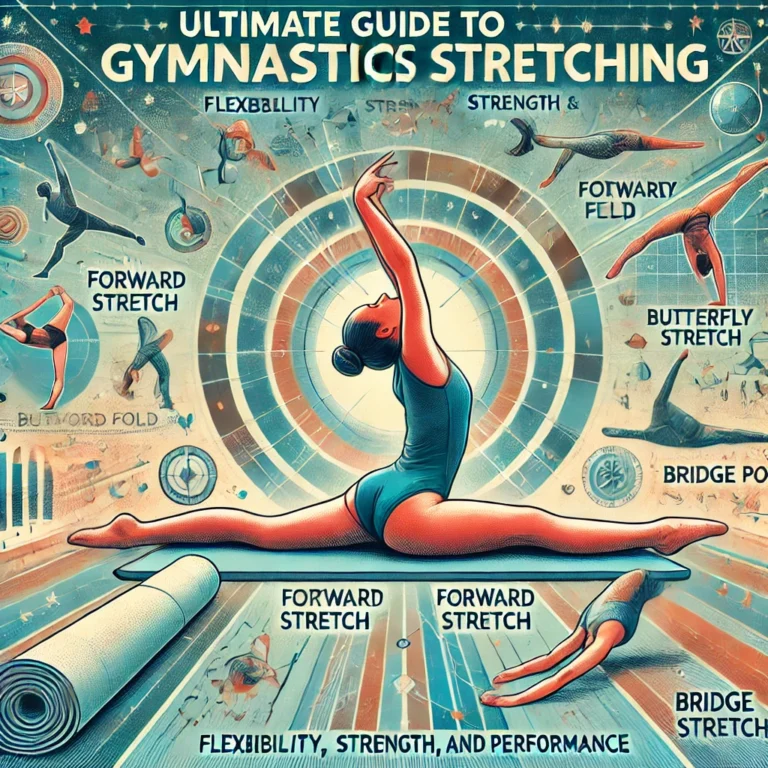
10 Comments
Comments are closed.